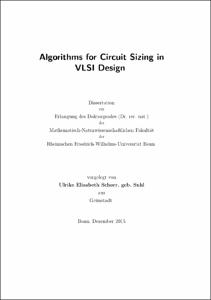Schorr, Ulrike Elisabeth: Algorithms for Circuit Sizing in VLSI Design. - Bonn, 2016. - Dissertation, Rheinische Friedrich-Wilhelms-Universität Bonn.
Online-Ausgabe in bonndoc: https://nbn-resolving.org/urn:nbn:de:hbz:5n-43305
Online-Ausgabe in bonndoc: https://nbn-resolving.org/urn:nbn:de:hbz:5n-43305
@phdthesis{handle:20.500.11811/6748,
urn: https://nbn-resolving.org/urn:nbn:de:hbz:5n-43305,
author = {{Ulrike Elisabeth Schorr}},
title = {Algorithms for Circuit Sizing in VLSI Design},
school = {Rheinische Friedrich-Wilhelms-Universität Bonn},
year = 2016,
month = may,
note = {
url = {https://hdl.handle.net/20.500.11811/6748}
}
urn: https://nbn-resolving.org/urn:nbn:de:hbz:5n-43305,
author = {{Ulrike Elisabeth Schorr}},
title = {Algorithms for Circuit Sizing in VLSI Design},
school = {Rheinische Friedrich-Wilhelms-Universität Bonn},
year = 2016,
month = may,
note = {
One of the key problems in the physical design of computer chips, also known as integrated circuits, consists of choosing a physical layout for the logic gates and memory circuits (registers) on the chip. The layouts have a high influence on the power consumption and area of the chip and the delay of signal paths. A discrete set of predefined layouts for each logic function and register type with different physical properties is given by a library. One of the most influential characteristics of a circuit defined by the layout is its size. In this thesis we present new algorithms for the problem of choosing sizes for the circuits and its continuous relaxation, and evaluate these in theory and practice.
A popular approach is based on Lagrangian relaxation and projected subgradient methods. We show that seemingly heuristic modifications that have been proposed for this approach can be theoretically justified by applying the well-known multiplicative weights algorithm. Subsequently, we propose a new model for the sizing problem as a min-max resource sharing problem. In our context, power consumption and signal delays are represented by resources that are distributed to customers. Under certain assumptions we obtain a polynomial time approximation for the continuous relaxation of the sizing problem that improves over the Lagrangian relaxation based approach. The new resource sharing algorithm has been implemented as part of the BonnTools software package which is developed at the Research Institute for Discrete Mathematics at the University of Bonn in cooperation with IBM. Our experiments on the ISPD 2013 benchmarks and state-of-the-art microprocessor designs provided by IBM illustrate that the new algorithm exhibits more stable convergence behavior compared to a Lagrangian relaxation based algorithm. Additionally, better timing and reduced power consumption was achieved on almost all instances.
A subproblem of the new algorithm consists of finding sizes minimizing a weighted sum of power consumption and signal delays. We describe a method that approximates the continuous relaxation of this problem in polynomial time under certain assumptions. For the discrete problem we provide a fully polynomial approximation scheme under certain assumptions on the topology of the chip.
Finally, we present a new algorithm for timing-driven optimization of registers. Their sizes and locations on a chip are usually determined during the clock network design phase, and remain mostly unchanged afterwards although the timing criticalities on which they were based can change. Our algorithm permutes register positions and sizes within so-called clusters without impairing the clock network such that it can be applied late in a design flow. Under mild assumptions, our algorithm finds an optimal solution which maximizes the worst cluster slack. It is implemented as part of the BonnTools and improves timing of registers on state-of-the-art microprocessor designs by up to 7.8% of design cycle time.
},
A popular approach is based on Lagrangian relaxation and projected subgradient methods. We show that seemingly heuristic modifications that have been proposed for this approach can be theoretically justified by applying the well-known multiplicative weights algorithm. Subsequently, we propose a new model for the sizing problem as a min-max resource sharing problem. In our context, power consumption and signal delays are represented by resources that are distributed to customers. Under certain assumptions we obtain a polynomial time approximation for the continuous relaxation of the sizing problem that improves over the Lagrangian relaxation based approach. The new resource sharing algorithm has been implemented as part of the BonnTools software package which is developed at the Research Institute for Discrete Mathematics at the University of Bonn in cooperation with IBM. Our experiments on the ISPD 2013 benchmarks and state-of-the-art microprocessor designs provided by IBM illustrate that the new algorithm exhibits more stable convergence behavior compared to a Lagrangian relaxation based algorithm. Additionally, better timing and reduced power consumption was achieved on almost all instances.
A subproblem of the new algorithm consists of finding sizes minimizing a weighted sum of power consumption and signal delays. We describe a method that approximates the continuous relaxation of this problem in polynomial time under certain assumptions. For the discrete problem we provide a fully polynomial approximation scheme under certain assumptions on the topology of the chip.
Finally, we present a new algorithm for timing-driven optimization of registers. Their sizes and locations on a chip are usually determined during the clock network design phase, and remain mostly unchanged afterwards although the timing criticalities on which they were based can change. Our algorithm permutes register positions and sizes within so-called clusters without impairing the clock network such that it can be applied late in a design flow. Under mild assumptions, our algorithm finds an optimal solution which maximizes the worst cluster slack. It is implemented as part of the BonnTools and improves timing of registers on state-of-the-art microprocessor designs by up to 7.8% of design cycle time.
url = {https://hdl.handle.net/20.500.11811/6748}
}






